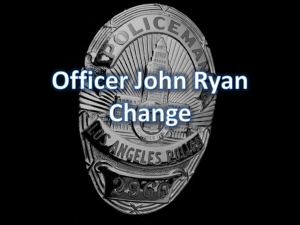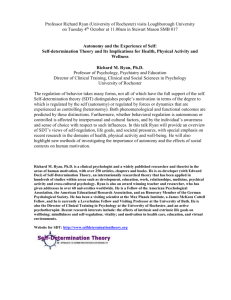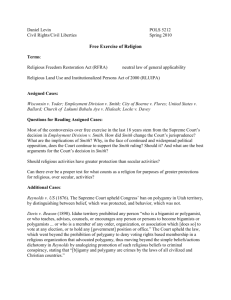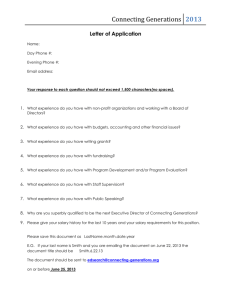WORD - Rowan University
advertisement
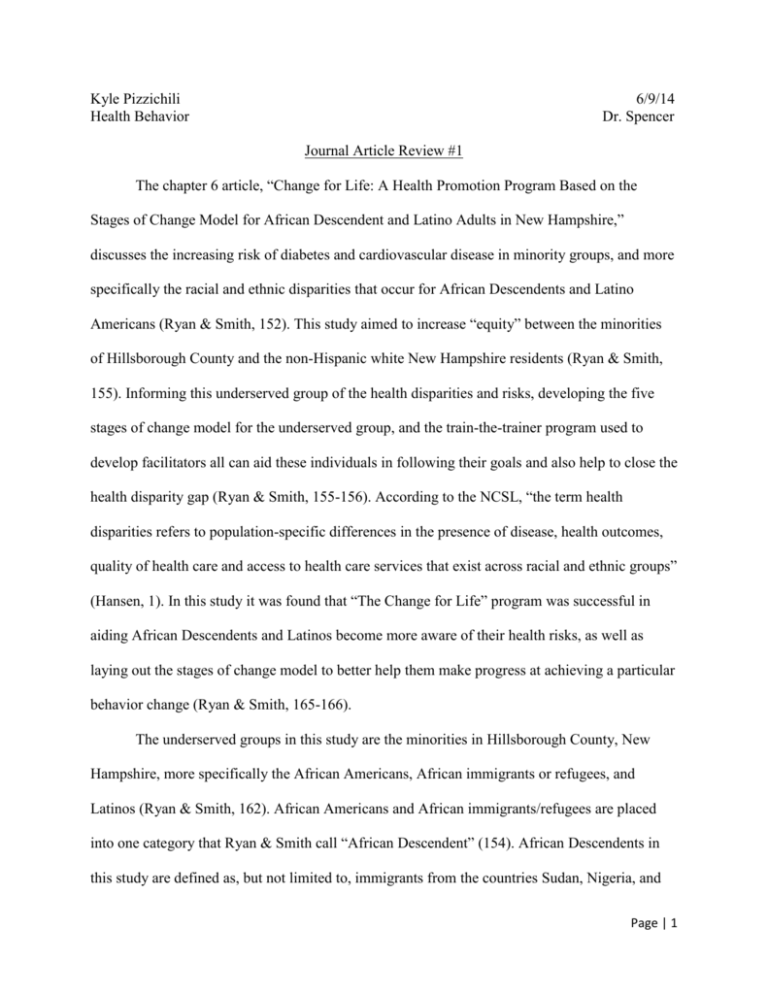
Kyle Pizzichili Health Behavior 6/9/14 Dr. Spencer Journal Article Review #1 The chapter 6 article, “Change for Life: A Health Promotion Program Based on the Stages of Change Model for African Descendent and Latino Adults in New Hampshire,” discusses the increasing risk of diabetes and cardiovascular disease in minority groups, and more specifically the racial and ethnic disparities that occur for African Descendents and Latino Americans (Ryan & Smith, 152). This study aimed to increase “equity” between the minorities of Hillsborough County and the non-Hispanic white New Hampshire residents (Ryan & Smith, 155). Informing this underserved group of the health disparities and risks, developing the five stages of change model for the underserved group, and the train-the-trainer program used to develop facilitators all can aid these individuals in following their goals and also help to close the health disparity gap (Ryan & Smith, 155-156). According to the NCSL, “the term health disparities refers to population-specific differences in the presence of disease, health outcomes, quality of health care and access to health care services that exist across racial and ethnic groups” (Hansen, 1). In this study it was found that “The Change for Life” program was successful in aiding African Descendents and Latinos become more aware of their health risks, as well as laying out the stages of change model to better help them make progress at achieving a particular behavior change (Ryan & Smith, 165-166). The underserved groups in this study are the minorities in Hillsborough County, New Hampshire, more specifically the African Americans, African immigrants or refugees, and Latinos (Ryan & Smith, 162). African Americans and African immigrants/refugees are placed into one category that Ryan & Smith call “African Descendent” (154). African Descendents in this study are defined as, but not limited to, immigrants from the countries Sudan, Nigeria, and Page | 1 Haiti, as well as the addition of the African Americans in Hillsborough County (Ryan & Smith, 154). The other underserved group is the Latino population which is defined as, “individuals from other U.S. states, Puerto Rico, the Dominican Republic, Mexico, Colombia, and other Latin American countries” (Ryan & Smith, 124). This is a very diverse population that is then placed in the minority category. To determine the differences between the general non-Hispanic white population of New Hampshire and the “blacks and Latinos” of Hillsborough County the REACH 2010 risk factor survey and the NH Behavioral Risk Factor Surveillance System (BRFSS) was used (Ryan & Smith, 154-155). Minorities were, when compared to the non-Hispanic white population, less physically active, had a lower average income, were less likely to have graduated high school, were less likely to be in the normal weight range (based on BMI), and they were also less likely to have health care let alone receive any (Ryan & Smith, 155). The health disparities are obvious and some of these may be attributed to the physical environment surrounding the underserved group (Ryan & Smith, 155). The neighborhoods in Manchester and Nashua are where the minority population predominately resided (Ryan & Smith, 155). These neighborhoods (their environment) lacked access to healthy foods and many of these low-income families were unable to purchase a car to be able to travel freely to supermarkets or such (Ryan & Smith, 155). Also, because in New Hampshire there are very long and dark winters these low-income minority families lack the funds to purchase a membership to any gym or recreational facility (Ryan & Smith, 155). So this underserved group is not getting the adequate amount of exercise and physical activity, as well as not eating enough healthier foods (fruits and vegetables) due to lack of access and funds. Page | 2 The structure for the Change for Life program is based on the Transtheoretical Model. This is also known as the stages of change model and includes five stages for assisting individuals in behavior change. The program consisted of “six 2-hour classes held weekly” which upon completion are followed by group support meetings (Ryan & Smith, 157). There were two separate programs, one geared towards the Spanish speaking population, called Cambia tu vida, and the other one for the English speaking population (Ryan & Smith, 157). Handouts were given out to summarize the steps of change and group exercises were performed to help the underserved group gain an overall better understanding of the triggers for their unhealthy habits they perform (Ryan & Smith, 157). Group support was the approach rather than an independent self-help program (Ryan & Smith, 156). After the curriculum was established modifications were made to better suit the minority population. Adding graphics to the handouts and other materials was recommended, as well as including different examples more relevant for this population (Ryan & Smith, 157). Also “the facilitator’s manual was revised to a sixth-grade reading level, and the participant workbook was written at a fourth-grade reading level” (Ryan & Smith, 157). After this was completed the results had to be translated into Spanish, they then tested and revised the curriculum based on the piloted tests (Ryan & Smith, 157). The train-the-trainer model used in this study was designed to train community facilitators to take over and run these programs (most of the time from their own homes) (Ryan & Smith, 159). A member of the NH REACH 2010 staff would, after the program, train community members in a 4-hour session where they would receive a facilitator’s manual and lesson plans for each session (Ryan & Smith, 159). I believe it is important to train facilitators in the community rather than just letting the REACH staff continue the program because people Page | 3 may feel more comfortable talking to someone from their own community and seeking them out for advice and mentoring. Also this enables individuals to take a leadership role in their community and help make a difference while the REACH staff can implement programs in other cities in the U.S. This program was evaluated using a quasi-experimental design which lacks random assignment in the experiment and gives the researcher more control over the assignment (Oswald & Price, 1). A traditional experimental design could be known as a randomized controlled trial because of the element of random assignment (Oswald & Price, 1). Quasi-experimental designs are effective because of the pre and post testing they do (Oswald & Price, 2). With this study the researchers chose to ask the participants to identify their stage of change “baseline, immediately after the last class, and 3 months after the last class using the decision tree” (Ryan & Smith, 160). At the post-program assessment (the 3-month follow up assessment) there was a 93% graduation rate for African Descendents and 71% graduation rate for the Latino population (Ryan & Smith, 161). I was personally shocked with the graduation rate for the program and I am surprised so many saw it through until the end. This just shows if you have a proper plan and execute it accordingly then you can succeed. I would have to say that for the African Descendents the rate was rather high, even though there were only 18 African Descendent responders in the beginning assessment. And the Latino rate was moderate to high in my opinion. In Table 3, the participants identified what stage of change they were in before the program and then again during the follow-up assessment. I seemed to identify a pattern throughout the table. During the baseline assessment majority of the participants were in the preparation stage, followed closely behind by the contemplation stage (Ryan & Smith, 163). And Page | 4 in the follow-up assessment the majority noticeably shifted into the action stage (Ryan & Smith, 163). To me it seemed like overall the program was successful based on the data that there was a beneficial transition into the next stages of change. This program used a group support and home-based model that was more appealing to the Latino population rather than the African Descendents. I believe this to be true because the Latino population tends to have larger families and sometimes a woman must stay home to care for the family. This enables more times available for these individuals to meet up and plan sessions more regularly. Another possibility could be that the Latino population has more desire to attend these classes because there was a Spanish version made specifically for them that can use to make themselves a better and healthier overall person. As stated in the article, African Descendents seem to be more drawn to a faith-based approach and one of the most successful community facilitators was actually an African American minister (Ryan & Smith, 166). I believe the program could be slightly tailored to fit any ethnic group and I do think that it can be successful in any environment. Page | 5 References Hansen, Melissa. 2014. “Health Disparities Overview.” National Conference of State Legislatures (NCSL). < http://www.ncsl.org/research/health/health-disparities-overview.aspx>. Accessed June 9, 2014. Oswald & Price. 2008. “Quasi-Experiments.” California State University, Fresno, Department of Psychology. <http://psych.csufresno.edu/psy144/Content/Design/Nonexperimental/quasi.html>. Accessed June 10, 2014. Ryan, A., Smith, C. 2006. “Chapter 6 Article: Change for Life: A Health Promotion Program Based on the Stages of Change Model for African Descendent and Latino Adults in New Hampshire.” Hayden, Joanna; editor. 2014. Introduction to Health Behavior Theory, 2nd Edition. p. 152-169. Jones and Bartlett Learning, LLC. Page | 6



